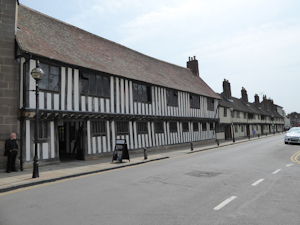
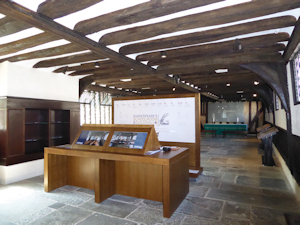
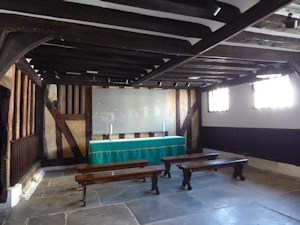
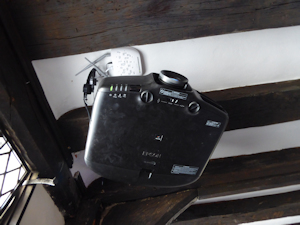
Figure 38: The Lower Guildhall visitor entrance
Figure 39: The 'Chapel' space in the Lower Guildhall
Figure 40: The EPSON EB-G6900WS projector




Dialogue between Richard Lithgow and David Masters of Imagemakers was also crucial to the development of digitally creative solutions for the preservation and interpretation of the paintings as part of the 'Shakespeare School' experience (Figures 37-39). Imagemakers were keen explore how digital solutions could help to orientate visitors within the complex chronology and changing functions of the medieval Guildhall and its subsequent conversion into the meeting place of the Corporation, Shakespeare's schoolroom, a courtroom and a performance space in the 16th century. Given that visitors were to enter the building from the ground floor, the remains of the guild chapel wall painting seemed to provide an obvious focal point to explain the religious purpose of the guild. However, the fragmentary nature of most of the painting required not only interpretation but also protection from natural light entering the building from windows in the west elevation, and from any projection onto the surface of the wall. Initially, Imagemakers and their consultants Atlas AV, selected a UV-resistant screen (2500 mm wide x 1500 mm long) onto which an interpretive narrative and reconstruction of the painting could be projected using an EPSN EB-G6900WS projector fixed in the southern corner of the ceiling in the last bay of the hall (Figures 40-41).
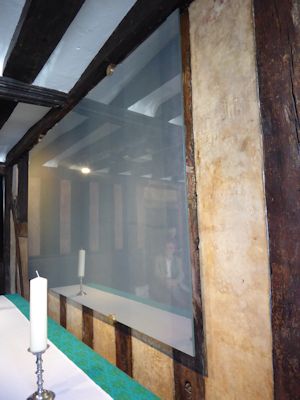
The screen was designed to act both as protection but as an interpretive medium, allowing the visitor to experience the palimpsest of the painted surface projected before them (Figures 42-46). A visual sequence commenced with the dimming of spotlights, and switching on of the glass screen. A series of images were then projected onto the surface of the screen: initially text and images explaining the function of the Guildhall chapel, followed by a reconstruction of the original image, projected to scale over the original, accompanied by a soundtrack of medieval plainsong, immersing the viewer sensorily in the 15th century guildhall chapel. This reconstruction was gradually annotated to explain the iconography, of the painting and then faded to be replaced by texts explaining why and how the paintings were covered up during the Reformation in the mid 16th century Figure 47).

At this point in the visitor experience the medieval plainsong was replaced by a soundtrack of a Tudor street, whilst the screen was gradually switched off, revealing once again the traces of the medieval iconography (Figure 48). The design and installation of the screen was informed principally by the need to provide UV-protection for the lake-based pigments of the scheme. However, the screen was commissioned prior to the discovery of the St. John the Baptist image and gradually, concerns emerged about the levels of protection it afforded to this figure. Moreover, the levels of opacity and extent of reflection of the screen made it difficult for visitors to see the original painting clearly. A few months after opening, the project team, conservators and academics re-engaged in discussion about the best way forward, and an even simpler solution of a drop down screen was developed onto which the sequence could still be projected (Figure 49 and 50), but which could also be raised to allow visitors to engage more directly and atmospherically with the original image, in low-level lighting conditions (Figure 51).
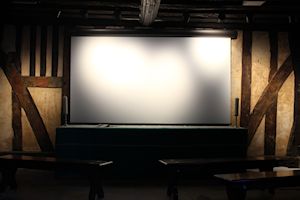
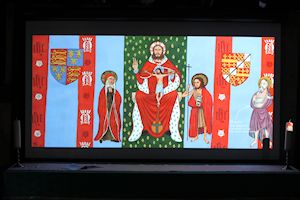
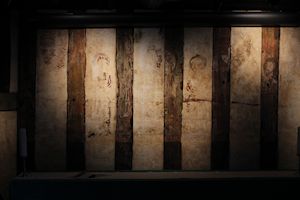
The outcome of this low-tech, but digitally creative solution to telling the story of Stratford upon-Avon's guildhall has opened up new creative possibilities for archaeologists, conservators and heritage professionals. The projected sequence orientates the visitor in both time and in space, allowing them to proceed from the guildhall chapel into the early modern Council Chamber (Figure 52) and upstairs to Shakespeare's School itself (Figures 53-55) and 'Master's Chamber' in the South Wing (Figure 56). In each of the rooms there are also unobstrusive touchscreens, providing visitors with text panels and touchscreens providing layers of further information allowing visitors to explore subjects such as the Guildhall, the Corporation, Court of Record, further (Figures 57a-d).
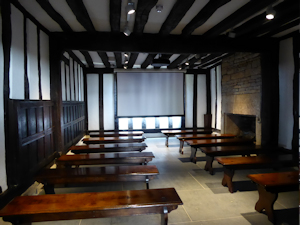
Imagemakers' digitally creative solution to our archaeological and historical desire to tell the story of the pre-Reformation Guildhall Chapel as well as that of Shakespeare's school responds to recent calls for sensory engagement with the medieval past (Giles 2007; Graves 2007; Woolgar 2006). It offers interesting interpretive possibilities for the future conservation and presentation of the adjacent Guild Chapel, with its much more impressive original scheme of medieval wall paintings but underwhelming appearance today. It therefore provides a model for academics and heritage professionals seeking to find new ways of telling the 'story' of the Reformation in the parish churches, cathedrals and monasteries which form such an important part of the UK's cultural heritage. Understanding the impact of the Reformation on England's medieval artistic and artefactual culture has only recently formed the focus for serious scholarly debate (see for example the landmark conference and publication by Gaimster 2003; Marks 2004; Marshall 2015 and earlier works by Aston 1988; Duffy 1992; Guinn-Chipman 2013). There is no doubt that digital creativity has much to offer this field, as the remarkable reconstructions and animations of now-lost medieval interiors at sites such as Holy Trinity Micklegate in York, Canterbury Cathedral, Glastonbury Abbey undertaken by the Centre for the Study of Christianity and Culture, attests.
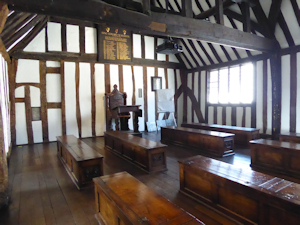
Telling the story of the Reformation in an increasingly secular and pluralistic society poses a challenge for heritage managers and academics who can no longer afford to make assumptions about visitors' cultural understanding of Christianity, liturgy or church buildings. This is particularly the case in Stratford-upon-Avon, where Shakespeare's appeal attracts international visitor communities and school groups unfamiliar with the complex cultural legacy of the middle ages and Catholicism in Shakespeare's world (Cooper 2010, Morse et al. 2013). The subject of Shakespeare's personal religious beliefs, those of his father and schoolmasters, have been the subject of intensive scholarly debate and popular imagination (see Green 2012, 86-87). Academics and critics have also raised questions about how a provincial, grammar-school educated boy could become one of Europe's greatest playwrights. Understanding and interpreting Shakespeare's cultural world through a scholarly examination of his works and contemporary historical sources, forms the focus of work at the Shakespeare Birthplace Trust: Edmondson and Wells 2013; and see the recent publication on Shakespeare's 'circle' of family and friends Edmondson and Wells 2015). Buildings such as the Guildhall speak as powerfully of this inheritance as does the Birthplace itself.
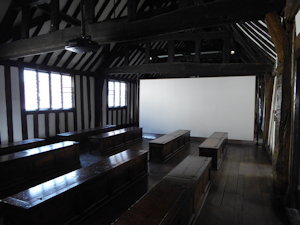
'Shakespeare's schoolroom' (Figures 53-55) has been reconstructed on the basis of the archaeological identification of this space as the schoolroom by Giles and Clark (2012, 156-57), and on historical research on Stratford-upon-Avon's grammar school by Gill (2012b) and its humanist curriculum by Green (2012):
'Shakespeare's Schoolroom & Guildhall is where it all began for William Shakespeare. It's where a bright Midlands schoolboy was educated and inspired to become the world's greatest playwright. Your visit to Shakespeare's Schoolroom & Guildhall will bring to life William's time as a schoolboy, from about 1571 to 1578. You'll find out how his outlook and ambitions were formed by the lessons he attended at the Guildhall and the plays he saw there. You'll follow in William's footsteps, exploring the classroom where he studied between the ages of 7 and 14. You can watch a short film about the kind of lessons he went to, and try some Tudor homework. You can even take part in a live Tudor lesson under the watchful eye of a 'master'! A visit to Shakespeare's Schoolroom & Guildhall has something for everyone. You'll have fun, and you'll discover amazing stories. You'll come a lot closer to knowing the real Shakespeare and understanding his formative childhood years'.
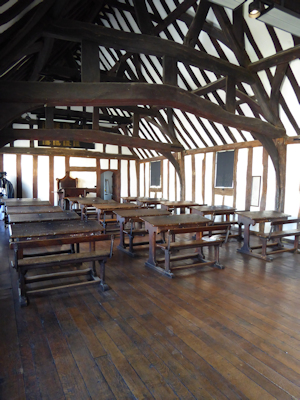
The schoolroom therefore provides a space in which visitors can begin to understand the 'idiosyncratic intellectual and artistic development' of the young William Shakespeare (Green 2012, 86). It is also a space in which Shakespeare is likely to have witnessed his first performances of plays, by the Earl of Leicester's company, or the Earl of Worcester's players, or possibly the Queen's Men, and indeed, such performances in the Guildhall might have provided him with his first walk-on part (Figures 57a-d, 56) (Green 2012, 92-93; Jones 2012; Mulryne 2012).
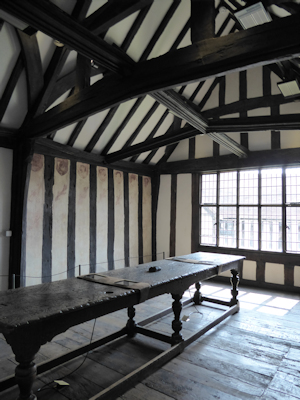
Recent tourism theory has suggested that the museum doesn't precede the tourist – awaiting their arrival – but is rather brought into being in the visitor experience (Staiff 2015). In many ways the Stratford-upon-Avon Guildhall experience can be understood to be moving away from an explicit 'learning paradigm' towards a much more participatory form of 'heritage-making' (Smith 2015). Indeed, enabling a performative and embodied rather than passive experience in the building may enable visitors to connect with the young Shakespeare in ways that are more commonly associated with literary birthplaces (Watson 2006).

It is, however, in the Guildhall chapel that the visitor is offered a glimpse into Shakespeare's complex religious cultural inheritance. Many early modern grammar schools were established within former guildhalls, where boys were surrounded by the physical traces of the medieval (Catholic) past. Whilst portable guild objects were often appropriated and transformed into the props of civic power, the traces of the devotional foci of guilds were harder to erase. For many years, the outlines of symbols and images must have emerged from the whitewashed walls of these buildings, as they did in parish churches. Mortises, brackets and fixings must also have provided reminders of the altars and statues that once accompanied them. Whatever the nature of Shakespeare's personal beliefs, his writings reveal a man powerfully aware of the power of 'bare ruined choirs' to evoke one of the most profound and traumatic experiences in England's cultural history.

Recent global politics have meant that iconoclasm and the destruction of cultural heritage has become a theme of intense debate in our own era. Stratford provides a lens though which we can understand how a religious ideology that had dominated cultural, social and spiritual life in England for centuries, could be transformed within a couple of generations; how one culture's form of artistic expression could be anathema to another; how iconoclasm sought to destroy the tangible traces of such faith, but how this was resisted, remembered and translated by subsequent generations. Digital technologies allow archaeologists to document and conserve this painted past. But they can also engender what Witcomb (2015) has described as a 'pedagogy of feeling', encouraging cross-cultural and cross-temporal encounters in which visitors are prompted to think about historical transitions and cultural dissonance in ways that question established relationships between self and other, in the past and in the present. The identification of Shakespeare's medieval cultural inheritance as an interpretative lacunae inspired the project team to take an 'interpretative leap in the dark', hoping that the reconstruction and digital projection of the lost wall painting might prove a subtle but effective way of engaging audiences with this vanished element of the Shakespeare story.

Internet Archaeology is an open access journal based in the Department of Archaeology, University of York. Except where otherwise noted, content from this work may be used under the terms of the Creative Commons Attribution 3.0 (CC BY) Unported licence, which permits unrestricted use, distribution, and reproduction in any medium, provided that attribution to the author(s), the title of the work, the Internet Archaeology journal and the relevant URL/DOI are given.
Terms and Conditions | Legal Statements | Privacy Policy | Cookies Policy | Citing Internet Archaeology
Internet Archaeology content is preserved for the long term with the Archaeology Data Service. Help sustain and support open access publication by donating to our Open Access Archaeology Fund.